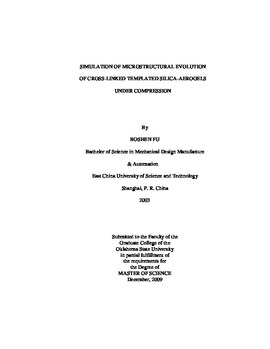| dc.contributor.advisor | Lu, Hongbing | |
| dc.contributor.author | Fu, Boshen | |
| dc.date.accessioned | 2014-04-17T19:52:21Z | |
| dc.date.available | 2014-04-17T19:52:21Z | |
| dc.date.issued | 2009-12-01 | |
| dc.identifier.uri | https://hdl.handle.net/11244/9930 | |
| dc.description.abstract | The evolution of a cross-linked templated aerogel mesostructure under compression was simulated using the Material Point Method (MPM) on a model generated from X-ray nano-computed tomographic image. The aerogel mesostructure is that identified in acid-catalyzed surfactant template materials, which after cross-linking with polyurea, demonstrate very high compressive yield strengths and energy absorption capabilities. In MPM each voxel occupied by aerogles in an X-ray tomograph was converted to a material point to generate a MPM model. A parallel version of MPM code, developed in our group, has been used to simulate the response of a cross-linked templated aerogels under compression at high strain rates. For a comparison with experimental data, a long split Hopkinson pressure bar was used to measure the stress-strain relationship of this material at high strain rates. The results from the simulations show that the MPM can effectively model cross-linked templated silica-aerogel considering its microstructure, and capture the elastic, compaction and densification behaviors of the aerogel, and the simulation results agree reasonably well with the experimental data. Simulations also indicate a nearly uniform compression at all three stages of deformation in the aerogel, consistent with experimental observations. Simulations were also conducted to indentify functions of ultra-thin polymer coating and the effect of density or porosity. Models with different porosities indicate that the skeletal wall thickness of both the silica particles and the polymer coating affect the local stress distribution, which in turn could induce different mechanical response under compression. MPM simulations show that the stress-strain behavior of cross-linked templated aerogels under compression follows a power law relation with bulk density. | |
| dc.format | application/pdf | |
| dc.language | en_US | |
| dc.publisher | Oklahoma State University | |
| dc.rights | Copyright is held by the author who has granted the Oklahoma State University Library the non-exclusive right to share this material in its institutional repository. Contact Digital Library Services at lib-dls@okstate.edu or 405-744-9161 for the permission policy on the use, reproduction or distribution of this material. | |
| dc.title | Simulation Of Microstructural Evolution Of Cross-Linked Templated Silica-Aerogels Under Compression | |
| dc.type | text | |
| dc.contributor.committeeMember | Hanan, Jay | |
| dc.contributor.committeeMember | Delahoussaye, Ronald | |
| osu.filename | Fu_okstate_0664M_10611.pdf | |
| osu.college | Engineering, Architecture, and Technology | |
| osu.accesstype | Open Access | |
| dc.description.department | Mechanical & Aerospace Engineering | |
| dc.type.genre | Thesis | |
| dc.subject.keywords | densification | |
| dc.subject.keywords | mpm | |
| dc.subject.keywords | nano-ct | |
| dc.subject.keywords | porosity effect | |
| dc.subject.keywords | silica-aerogel | |
| dc.subject.keywords | tomography | |
